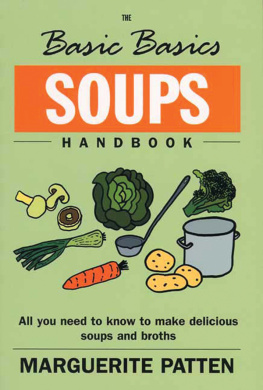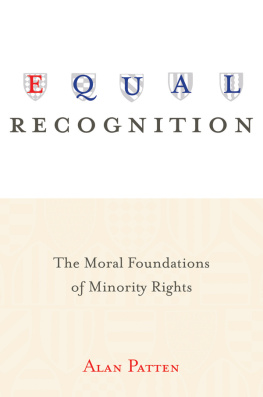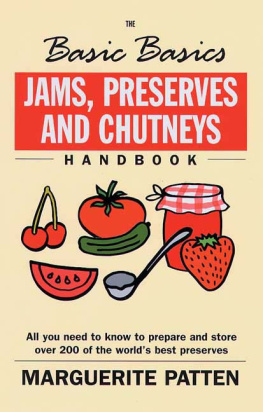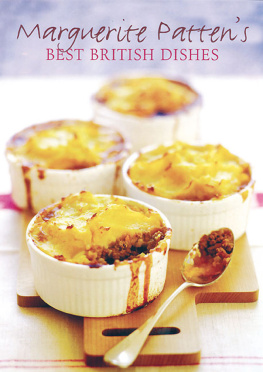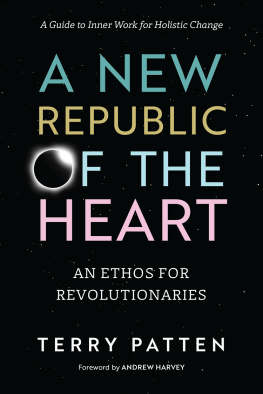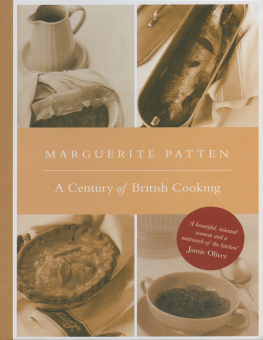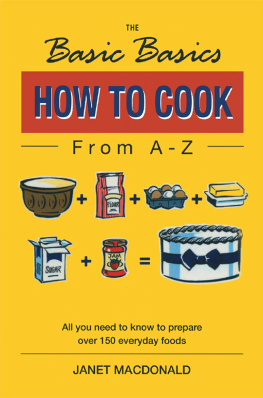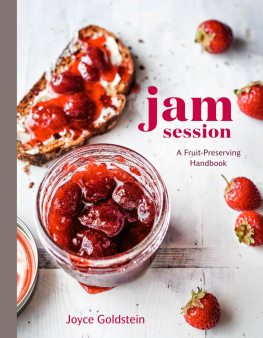
MARGUERITE PATTEN
This new edition published by Grub Street
4 Rainham Close, London SW11 6SS
Copyright this revised edition Grub Street 2002
Text copyright Marguerite Patten, 1996 and 2002
First published as Soups in 1996 by Bloomsbury Publishing Plc
Jacket design by Hugh Adams
Reprinted 2004, 2005, 2007, 2009
The moral right of the author has been asserted.
British Library Cataloguing in Publication Data
Patten, Marguerite
The basic basics soups handbook
1. Soups
I. Title II. Soups handbook
641. 813
ISBN 1 904010 19 9
eISBN 9781908117670
Mobi ISBN 9781908117670
All rights reserved. Apart from any fair dealing for the purposes of private study, research, criticism or review, as permitted under the Copyright Act, no part of this book may be reproduced or transmitted in any form or by any process without permission in writing from the publisher.
MEASUREMENTS
All the recipes in this book give metric, imperial and American weights and measures. Note that American pints and tablespoons are smaller than the British equivalent.
Use measures from one column only - do not mix them.
All spoon measures are level.
Soups are not like cakes, where strict adherence to a recipe is important to maintain the balance of ingredients. In a soup the quantity of each ingredient is very much a matter of personal taste, but the recipes have been tested with the quantities given.
Choice of Ingredients
Where recipes give a choice of ingredients, such as butter or margarine, vegetable or chicken stock, the first-mentioned ingredient is my preferred choice.
INTRODUCTION
Soup of the evening, beautiful soup!
Beautiful soup! who cares for fish,
Game, or any other dish?
Who would not give all else for two
Pennyworth only of beautiful soup?
Lewis Carroll (1832-98)
I do not entirely agree with the words spoken in Alice in Wonderland about the time to eat beautiful soup. I welcome it in the middle of the day and late at night, as well as in the evening. Many soups are economical dishes, though the cost today may be a little more than two pennyworth. Soup is easy to digest and wonderfully soothing, so it is ideal when you are rather tired and unwilling to eat more solid foods. Hot soups are warming in cold weather and cold soups refreshing in the heat of summer.
Soup has been an important part of family and special occasion meals in many countries of the world for centuries. It is reported that the Ancient Greeks ate black broth (presumably a type of soup), but sadly I do not have a recipe for this. The Romans made soup, known as polus, and the historian Apicus records the impressive selection of vegetables, herbs and seasonings they used in cooking them.
The countries occupied by the Romans all have a great tradition of soup-making. Although the word polus is not used today, it was undoubtedly the origin of the French word potage. In England this became pottage, which has been used for centuries to describe some British soups.
The first chapter of this book gives information to help you make soups that have a perfect flavour and consistency. It includes recipes for various stocks the secret of many good soups although modern stock (bouillon) cubes can be used as an alternative when home-made stock is not available.
Our approach to stock has changed a great deal: no longer is there a large pot on the kitchen range into which liquid, leftover bones and other foods have to be boiled daily in an effort to stop the contents becoming rancid. Nowadays the stock is kept in the safety of the refrigerator or freezer, awaiting the time when it can be used. There is clear information about freezing stock in and also at the end of recipes, for it is a great asset to have containers of soup waiting for you to heat as required.
Stock can be prepared in various ways: apart from in a saucepan, in the oven, in a microwave or in a pressure cooker (see ).
It is a mistake to think one needs a vast selection of ingredients to make a good soup quite the contrary. If you make a tomato soup, or order it in a restaurant, you expect the soup to have a definite flavour of tomatoes. If, due to an over-long list of other ingredients, the tomato taste has been lost, it is not a good soup. Carefully chosen herbs, spices and other suitable ingredients must be chosen to enhance the flavour of the basic ingredient(s). You will find information about these in .
Knowing how many keen cooks are short of time, is devoted to Quick Soups. Each of the varied recipes can be cooked within 30 minutes. The soups are based on vegetables, fish, meat, chicken, fruit and cheese.
Clear Soups follow in . These will be enjoyed by people who appreciate the flavour of a classic consomm, and are ideal if you want to lose a little weight. There are many suggestions for giving a special touch to consomms, together with other clear soups, including those based on beer or wine. These retain an alcoholic flavour, but the alcohol content is destroyed during cooking.
includes vegetable soups from around the world, but all have one thing in common I have kept the cooking times to a minimum to retain the flavour, colour and texture of the ingredients. This is a change from old-fashioned vegetable soups, where the cooking time was so long that the lovely fresh flavour of the vegetables was lost.
Obviously, this chapter will be of special appeal to vegetarians. Although some recipes suggest using chicken stock vegetarians can easily substitute vegetable stock (see ) or water with a vegetable stock cube.
Soups based on fish, meat, poultry and game fill . Many of these soups are sufficiently satisfying to make a complete light meal, particularly the chowders, broths and intriguing sticky gumbo soups.
In many countries soups based upon fruit are traditional favourites. We in Britain, alas, have not established that tradition. Fruit soups can be an appetizing and refreshing start to a meal at any time of the year, but they must be made with a subtle mixture of sweet and sharp or savoury flavours, so it does not appear you are serving a fruit dessert at the start of the meal. My favourite fruit soups are in .
Hot soups far outnumber cold soups in this book, as hot ones are more popular. Sometimes, however, a hot soup can be turned into a cold one by adding a little extra liquid so that the consistency is perfect when the ingredients cool. As a lover of chilled, jellied and even iced soups, I am delighted to find that more and more people are discovering the virtues of cold soups on a warm day. You will find a good selection in .
I hope you will enjoy using this book and, like me, you will extol the virtues of good home-made soups at all times.
M ARGUERITE P ATTEN
1 PERFECT SOUPS
T here is such a wide range of soups, based on an almost endless variety of ingredients and flavours, that it may sound difficult to give a few golden rules about making good ones. In fact, it is relatively simple to summarize these.
Flavour: Generally, soup is the first course of a meal, or the second course if served after an hors doeuvre: as such, the flavour must not be so pronounced that it will overwhelm the taste of the foods that are to follow; it should be interesting but not too strong. This point is emphasized in the introduction to the various chapters.
Next page
